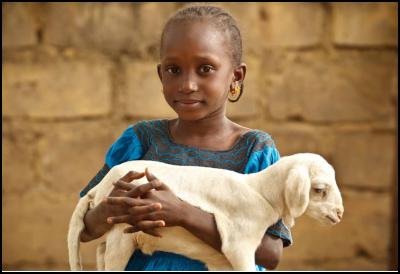Ghoulish, US Live Animal Charity Has Poor Track Record
Ghoulish, US Live Animal Charity Has Poor Track Record
by Martha
Rosenberg
November 4, 2013

Just in time for Halloween, Heifer International's new catalogue hit the US mail. Heifer International is a Little Rock-based Christian charity that "ends hunger and poverty" through sending live animals to poor people overseas. The images of cute kids hugging cute animals, many of whose throats will be slit after the cameraman leaves, are right out of Walt Disney or Pet World. If she were alive today, Dorothy Parker would "frow up."
This year's catalogue of cherubic children and smiling market women with perfect teeth and clothes, tells donors their live animal gift will feed families, help the poor rise above poverty and "empower women around the world to overcome…[the] burden of discrimination."
"Before receiving a gift of ducks from a Heifer supporter, Pham Thi Nguyen from Viet Nam remembers, 'In the past, my children would be sick often,'" says the catalogue. "Now we have more money to improve our house and send our children to school."
How do people with no food feed animals, people with no money provide veterinary care and shelter for animals and people with no resources keep animals from harm and being lost and stolen?
If poor families can’t “grow enough feed” they "are taught the best substitutes to buy locally," says a Heifer International newsletter. Yes, buy. When animals get sick, families can use “local natural substances that are known to provide specific medicinal benefit.” Families can also build shelters out of "locally available materials," the newsletter assures donors. Heifer does not address the risks of zoonotic diseases and swine and avian flu outbreaks to the poor communities. Maybe there are "natural" vaccines.
Another question is why Heifer sends milk-producing animals to countries where 80 percent of the population is lactose intolerant? Heifer received funding from the Bill & Melinda Gates Foundation to open dairy operations in Kenya, Uganda and Rwanda, replete with chilling plants, backup power generators and "refrigerated commercial dairy delivery trucks." Why are dairy operations and animal-based agriculture in general, which wastes 80 percent of plant and grain crops, an upgrade for poor countries?
Two teachers who Heifer sent on a tour saw the downside of this insipid business plan when they visited a Honduras community that received live animal gifts. A “disease killed off all the chickens in a particular village,” and children were sleeping with the animals to keep them from being stolen, they reported. Heifer recipients are also reported to be feeding their animals over their children because it is a better return on investment, according to some anecdotal reports. Thanks, Heifer.
Fifteen years ago in Chicago, a Heifer International attempt at a domestic animal poverty project also failed. A aquaculture operation was set up in a Chicago housing project so at risk youth could sell fish to area restaurants and embark on promising livelihoods. But in 1999 all the fish froze to death when the heat and power went off. Two years later, the same thing happened only this time the air conditioning went out because of a storm. The fish leaped “out of their barrels trying to escape accumulating ammonia and rising temperatures,” said the Chicago Tribune.
Many in the US are mourning the death of more than 20,000 head of cattle and calves who froze to death in a freak blizzard in South Dakota. The sight of the poor mammals, huddled together in a last, vain attempt to retain their warmth and evade their fate is heartbreaking. What is the fate of live animals shipped to poor countries when the world's richest country could not prevent such a shocking, tragic die-off?
Martha Rosenberg is a health reporter whose new book, Born with a Junk Food Deficiency--How Flaks, Quacks and Hacks Pimp the Public Health (Random House) was named in the ASJA 2013 Outstanding Book Awards. A great holiday gift, it is available in bookstores and online.


 Martin LeFevre - Meditations: In A Global Society, There Is No Such Thing As “National Security”
Martin LeFevre - Meditations: In A Global Society, There Is No Such Thing As “National Security” Binoy Kampmark: Secrecy And Virtue Signalling - Another View Of Signalgate
Binoy Kampmark: Secrecy And Virtue Signalling - Another View Of Signalgate Gordon Campbell: On The Americanising Of NZ’s Public Health System
Gordon Campbell: On The Americanising Of NZ’s Public Health System Ian Powell: Trumpian Health Leadership
Ian Powell: Trumpian Health Leadership Eugene Doyle: Disruption - Historians Challenge Russophobic Propaganda
Eugene Doyle: Disruption - Historians Challenge Russophobic Propaganda Ramzy Baroud: War, Doublethink, And The Struggle For Survival - Geopolitics Of The Gaza Genocide
Ramzy Baroud: War, Doublethink, And The Struggle For Survival - Geopolitics Of The Gaza Genocide